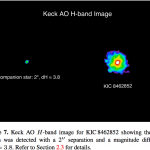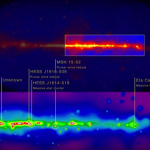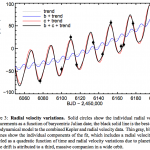Astronomy
"A mouse does not rely on just one hole." -Plautus
When you look at the largest, most powerful optical telescopes in the world, they all have something in common: they all have holes in their central, primary mirrors. This is for a few reasons, including that they're all reflectors, they all need to focus light somewhere in front of the mirror, and they all need to send that light somewhere to be recorded and analyzed.
Image credit: Wikimedia Commons user Eudjinnius, of a diagram of Herschel-Lomonosov telescope system.
You can, in principle, focus the light somewhere off-axis, and…
"We find them smaller and fainter, in constantly increasing numbers, and we know that we are reaching into space, farther and farther, until, with the faintest nebulae that can be detected with the greatest telescopes, we arrive at the frontier of the known universe." -Edwin Hubble
If you want to see farther, deeper and at higher resolution than ever before into the Universe, you need four things: the largest aperture possible, the best-quality optical systems and cameras/CCDs, the least interference from the atmosphere, and the analytical techniques and power to make the most of every…
“These theories were based on the hypothesis that all the matter in the universe was created in one big bang at a particular time in the remote past.” -Fred Hoyle
It’s making headlines every time someone brings it up: a quantum calculation, a new theory or some mathematical evidence proves it once and for all: there was no Big Bang.
Image credit: NASA / STScI / A. Felid.
Is that even possible? Honestly, it depends on which definition of the Big Bang you’re using. As it turns out, there are two of them, and there’s a good (historical) reason for that. But in the context of what we…
"It’s becoming clear that in a sense the cosmos provides the only laboratory where sufficiently extreme conditions are ever achieved to test new ideas on particle physics. The energies in the Big Bang were far higher than we can ever achieve on Earth. So by looking at evidence for the Big Bang, and by studying things like neutron stars, we are in effect learning something about fundamental physics." -Martin Rees
Neutron stars are some of the most extreme objects in the Universe: a ball of neutrons a few kilometers in diameter, but with more mass than the entire Sun in them. Their magnetic…
"Most people don't know what's happening around them because they're just speeding through life. And before they know it, they're just old. So I just try to slow it down." -Tracy Morgan
Travel fast enough through the air, and you'll exceed the speed of sound. The compressed air in front of you builds up, denser and denser, creating a shock wherever you've exceeded the sound barrier. In interstellar space, stars that move fast enough do the exact same thing.
Image credit: GALEX, NASA’s Galaxy Evolution Explorer.
There doesn't need to be sound in space for runaway stars to compress gas,…
"Think about it this way - a boomerang goes out and comes back to you if you throw it. If you throw it out at the universe, it will come back down to you on Earth." -J. B. Smoove
Give a planet a kick, and it goes into a more distant orbit around our star. Give it a hard enough kick, and it will reach escape velocity, leaving our Solar System forever. But if you gave it an almost hard enough kick, it would travel extremely far from the Sun, but it would eventually boomerang back towards the inner Solar System, with potentially disastrous, disruptive consequences. This applies to any…
"Now the world has gone to bed,
Darkness won't engulf my head,
I can see by infrared,
How I hate the night." -Douglas Adams
In 1990, the Hubble Space Telescope was launched and deployed, becoming the first space-based observatory. In the years since, many others have followed, covering the entire electromagnetic spectrum, but with nothing superseding Hubble over the wavelengths it covers. That will all change with the James Webb Space Telescope, currently on schedule and almost ready for its October 2018 launch date.
Image credit: NASA / JWST / HST team.
The science instruments are all…
"So numerous are the objects which meet our view in the heavens, that we cannot imagine a point of space where some light would not strike the eye;—innumerable stars, thousands of double and multiple systems, clusters in one blaze with their tens of thousands of stars, and the nebulae amazing us by the strangeness of their forms and the incomprehensibility of their nature, till at last, from the limit of our senses, even these thin and airy phantoms vanish in the distance." -Mary Fairfax Greig Somerville
The distant nebulae might appear to illuminate the night sky, but this neutral gas is…
"Science, however, gives me the feeling of steady progress: I am convinced that theoretical physics is actual philosophy. It has revolutionized fundamental concepts, e.g., about space and time (relativity), about causality (quantum theory), and about substance and matter (atomistics), and it has taught us new methods of thinking (complementarity) which are applicable far beyond physics." -Max Born
The farther away we look in the Universe, the farther back in time we look as well, since light has a finite speed. But if a galaxy's light takes a million years to reach you, that galaxy is going…
“Finding out that something you have just discovered is considered all but impossible is one of the joys of science.” -Mike Brown
Earlier today, the team of Pluto-killer Mike Brown and Konstantin Batygin announced that they had found evidence of a ninth planet in our Solar System beyond the orbit of Pluto, larger and more massive than even Earth.
However, a closer inspection of the work shows that they predict a few things that haven't been observed, including a population of Kuiper belt objects with large inclinations and retrograde orbits, long-period Kuiper belt objects with opposite…
"You will never be happy if you continue to search for what happiness consists of. You will never live if you are looking for the meaning of life." -Albert Camus
If you ask the average person where you can find new stars in our galaxy, they might (correctly) identify the Orion Nebula, a hotbed of star formation where thousands of new stars are presently being born. But at ~1,500 light years away, it's not the closest place where new stars are forming, not by a long shot.
Image credit: ESO/Digitized Sky Survey 2; Acknowledgement: Davide De Martin.
Instead, the southern hemisphere holds…
"Thou shalt not embarrass thyself and thy colleagues by claiming false planets." -Bill Cochran
Last year, Penn State astronomer Jason Wright made headlines by claiming that one of the stars being observed by NASA's Kepler mission might contain alien megastructures around it. The large dips in its light curve didn't make sense in the context of planets, and the star KIC 8462852 became the target of a great many follow-ups.
Image credit: Infrared: IPAC/NASA (2MASS), at left; Ultraviolet: STScI (GALEX), at right.
A binary companion was found, along with no signs of excess infrared emission or…
“Beauty provokes harassment, the law says, but it looks through men's eyes when deciding what provokes it.” -Naomi Wolf
Geoff Marcy. Tim Slater. Christian Ott. And a great many more who are just waiting to be publicly exposed for what they've done (and in many cases, are still doing). Does it mean that astronomy has a harassment problem? Of course it does, but that's not the real story.
U.S. Department of Education Program Legal Group (Title IX), from the United States Department of Agriculture. Image credit: USDA photo by Lance Cheung.
The real story is that, for the first time, an entire…
"When their eyes grew dim with looking at unrevealing dials and studying uneventful graphs, they could step outside their concrete cells and renew their dull spirits in communion with the giant mechanism they commanded, the silent, sensing instrument in which the smallest packets of energy, the smallest waves of matter, were detected in their headlong, eternal flight across the universe." -James Gunn, on Radio Astronomy
From the time that neutral atoms first formed in the Universe (the creation of the CMB) until the first stars formed, perhaps 100 million years passed. Yet these "dark ages"…
"If you take a galaxy and try to make it bigger, it becomes a cluster of galaxies, not a galaxy. If you try to make it smaller than that, it seems to blow itself apart." -Jeremiah P. Ostriker
13.8 billion years ago, the Universe as we know it was born with no stars, no clusters and no galaxies. But over time, gravitation has built up all sorts of complex structures, with the largest galaxy cluster today, El Gordo, weighing in at 3 quadrillion Suns.
The El Gordo galaxy cluster, imaged by the Hubble Space Telescope and with the dark matter mapped out. Image credit: NASA, ESA, J. Jee (…
"Observing quasars is like observing the exhaust fumes of a car from a great distance and then trying to figure out what is going on under the hood." -Carole Mundell
Have you been tunes in to Starts With A Bang during this past week? The first full week of January brings with it the annual American Astronomical Society's giant meeting, and some of the most important discoveries and developments of the year! If you missed anything, here's what we've covered:
Is interstellar travel possible? (for Ask Ethan),
A distant galaxy cluster reveals the power of Einstein's…
"I happen to have discovered a direct relation between magnetism and light, also electricity and light, and the field it opens is so large and I think rich." -Michael Faraday
With the launch of the Fermi satellite in the late 2000s, we began observing the highest energy photons in the Universe -- gamma rays -- all over the sky, to unprecedented precision. Produced from cosmic ray showers in space when high energy protons run into other, stationary protons, these gamma rays locate point sources from supermassive black holes to supernova remnants to pulsars.
Image credit: NASA’s Goddard…
“The paradigm of physics — with its interplay of data, theory and prediction — is the most powerful in science.” -Geoffrey West
Cosmic inflation, our earliest theory of the Universe and the phenomenon that sets up the Big Bang, didn't just explain a number of puzzles, but made a slew of new predictions for the Universe. In the subsequent 35 years, five of the six have been confirmed, with only primordial gravitational waves left to go.
Image credit: NASA / WMAP science team.
Inflation predicts that they could be large or small, but based on the simplest classes of models and the measured…
"Mars is much closer to the characteristics of Earth. It has a fall, winter, summer and spring. North Pole, South Pole, mountains and lots of ice. No one is going to live on Venus; no one is going to live on Jupiter." -Buzz Aldrin
When a planet passes in front of its star from our point of view, that transiting phenomenon can be detected as a dip in starlight. By surveying some 150,000 stars, the Kepler mission has detected close to 10,000 planetary candidates, many of which have been identified by the stellar wobble technique.
Image credit: NASA Ames.
But this "wobbling" also sometimes…
“You're on Earth. There's no cure for that.” -Samuel Beckett
In 2012, astronomers announced that the nearest star system to us, the Alpha Centauri system, possessed at least one exoplanet around it. A periodic signal that recurred just every 3.24 days was consistent with an Earth-sized exoplanet orbiting and gravitationally tugging on the second largest member of the star system: Alpha Centauri B.
Image credit: PHL @ UPR Arecibo, via http://phl.upr.edu/press-releases/aplanetarysystemaroundourneareststari….
That planet, named Alpha Centauri Bb, turns out not to actually be there. A…
















